Can You Lose Weight with Yoga?
Yoga can be very helpful for treating obesity and losing weight, but only if it’s used with healthy eating, stress management, and better sleep. The last thing I want for you is to read this blog, do the poses, and then expect you’ll magically lose 25 pounds in one month.
Weight loss is a result of several internal and external factors such as genetics, hormones, diet, quality of food, stress, and finally exercise. You can’t expect to effectively lose weight without taking all these factors into account.
That being said, yoga can be very helpful for losing weight, even more so than other types of exercise, because of its emphasis on breathing and body awareness, which can help to manage stress. It also improves your decision-making skills, helping you live a healthier lifestyle. Along with that, it builds strength, flexibility, and mobility to prevent you from getting injured, so you can keep working out towards your goals!
In this blog I’ll cover:
- How Yoga Helps You Lose Weight
- How Often Should You Do Yoga to Lose Weight?
- Yoga Poses for Weight Loss – Strength & Stress Relief
- Conclusion
- Additional Resources
How Yoga Helps You Lose Weight
There are many forms of yoga from yin yoga, which is more restorative, to MFY that focuses more on strengthening your core and foundational strength, including your overall strength, balance, flexibility, and mobility.
Each has their own benefits, but if you’re looking to lose weight, then focusing on a more strength-based practice is better for you. Yoga practiced in this way has three primary benefits explained below.
Yoga Builds A Strong Core And Body Awareness
There is no simple trick to losing weight, but developing a strong core is one important step that will help you lose weight in the long run. Your core involves muscles in your abdomen, back, sides, pelvis, and butt that all work together to stabilize your spine, keep your posture, and help you balance.
Therefore, by developing your core you build a strong foundation base of support for virtually any movement, which, in turn, helps you exercise more effectively and with a lowered risk of injury.
Yoga is also helpful in this regard because it increases your overall body awareness. You’ll learn how to activate muscles to properly align yourself through movements of exercise and everyday life to move safer and more effectively.
Yoga Helps You Avoid Injuries
Although not impossible, it’s harder to lose weight if you can’t exercise. Yoga is important for exercise in this regard because it helps you prevent injury, enabling you to exercise. Injury doesn’t necessarily mean all exercise options are eliminated. (I prefer to look at injuries as opportunities to work on other areas of fitness.) But it does limit your options.
Why does yoga help with injury prevention? A lot of reasons. The movements involved helped to build isometric strength, increase your flexibility and mobility, correct muscular imbalances, and facilitate muscle recovery. All of these combined are extremely helpful for lowering your risk of preventable injury.
Yoga is most noticeably helpful in injury-prevention when it comes to minor muscle strains like hamstring or quadriceps tears, achilles tendinitis or similar inflammation from overuse, and, perhaps most importantly, improving core strength to prevent strains in your back. Although the list of why yoga can directly and indirectly help with injury-prevention is long, the bottom line is that if done effectively with proper technique, yoga is going to help dramatically lower your risk of preventable injury.
Yoga Helps You Manage Stress
Everyone knows stress is bad for you, but it actually causes physical, behavioral, and physiological in everyone that can result in headaches, upset stomach, poor sleep, poor diet, and obesity.
Under stress, people often turn to emotional eating or overeating processed foods high in fat, salt, and sugar. These foods are often very calorically dense and not as nutritious as unprocessed foods such as vegetables, fresh meat, and fish, which leads to weight gain.
However, by managing your stress with yoga you can lower these cravings and even get a better night’s sleep. Yoga is extremely effective in this way because it pairs diaphragmatic breathing with healthy exercise to lower your stress.
I know it sounds silly, but studies show that learning to breathe deeper from your diaphragm can greatly reduce your stress.
Yoga Helps You Make Better Decisions For A Healthy Lifestyle
A healthy yoga routine can be the starting point for creating healthy habits for keeping that weight off in the long run, because losing weight isn’t just a few months of hard dieting and exercise, but rather a slow marathon of developing a healthy routine that pairs healthy eating with a good amount of exercise.
By simply setting out a yoga mat in plain sight every day, you can remind yourself to practice yoga and slowly build that habit, which will lead you to eventually build more healthy habits – like eating healthy, going on walks, keeping a check on your posture.
Even small decisions such as choosing to eat an apple over some chocolate can accumulate, ultimately changing your lifestyle for the better.
Losing weight or building a habit isn’t about sheer willpower but more about making it as easy as possible for you, if you want to learn more about habit science click here.
Looking for A Program?
If you’re looking for workouts to help you lose weight, gain muscle, and increase your flexibility, then Man Flow Yoga has you covered with on-demand structured programs that complement your lifestyle and schedule. Sign-up below to try our 7-Day Challenge!
Signup for the FREE 7-Day Challenge
How Often Should You Do Yoga to Lose Weight?
Doing yoga once a week does have some benefits, but to start really effectively building a strong core, managing stress, and losing weight, you need to at least practice yoga 3x a week. These don’t have to be insane strenuous workouts, but they should still be challenging.
Yoga Poses for Obesity
There are two types of yoga you should be doing to lose weight through exercise: yoga for engaging your core AND yoga for stress management. These types of yoga will help you lose weight along with a healthy diet and sleep schedule.
Exercises Focusing on Core Strength:
These poses are meant to strengthen your core and target minor muscles as well. However, some of these might be challenging and require some strength in order to do them safely and properly. If the exercise is too difficult, then many of these poses have modifications that will make them manageable. However, you should still focus on correct muscle engagement.
Exercise 1: Boat Pose
Technique:
- Sit on the floor, bend your knees, and place your feet flat on the floor, with your heels 11⁄2 to 2ft (45–60cm) away from your hips.
- Lightly grip your knees with your hands, sit as upright as possible, and lean back slightly.
- Keeping your chest lifted and your torso still, squeeze your hip flexors and abdominal muscles toward each other to engage core.
- Let go of knees, and reach arms forward and up, palms up.
- Continue to firmly engage your abdominal muscles and hip flexors, and slowly lift feet off the floor and straighten legs. Pull sternum toward the ceiling while keeping spine neutral.
- Hold the posture, inhaling as you lengthen the spine, and exhaling as you tighten the core.
Modifications: If you are unable to extend your legs without your chest caving in, keep legs bent, lightly rest feet on the floor, or keep hands lightly wrapped around knees for support.
Exercise 2: Chair Pose
Technique:
- Stand with your feet together, toes facing straight forward. (It’s okay to angle toes slightly outward at first, if needed.) Slightly arch your lower back.
- Raise arms to shoulder height, palms facing the ceiling.
- Keeping your chest upright, slowly lower your hips down and back into a squat until hips are just below the knees.
- Press down firmly through your heels, the balls of your feet, and your toes.
- Drive knees outward to engage glutes. Keep arms extended in front of you to maintain balance.
- Hold the posture, inhaling as you lift the chest and get taller, and exhaling as you sit deeper.
Modifications: If it is difficult to remain upright while arching your back and squatting, hold on to a sturdy external support, and use it to lean back and sit deeper.
Exercise 3: Warrior 3
Technique:
- Stand in the middle of your mat and step your left foot back 2 to 3ft (0.5–1m).
- Rise onto the ball of your left foot and bend your right knee into a shallow lunge. Keep hips and feet facing forward.
- Lengthen torso and keep chest upright.
- Raise your arms overhead, press palms together, and interlace fingers with index fingers extended.
- Inhale as you lengthen your body, then exhale as you press down through the right foot and lift left leg.
- Hinge at the hips until your torso is parallel to the floor, and straighten your left leg until you feel a stretch through left hamstrings. (You don’t have to lock your leg.)
- Firmly engage glutes and core to keep torso and left leg in a straight line. Make body as long as possible by pressing fingertips and toes away from each other.
- Hold the posture, inhaling as you lengthen the spine, and exhaling as you tighten your core.
- Repeat on the other side.
Modifications: If it is difficult to keep your fingers interlaced, hold a strap with hands shoulder-width apart, instead. If it is difficult to hinge to the degree shown in step 2, don’t go as deep; focus on maintaining a straight line from the back toes to fingertips.
Exercise 4: Forearm Plank
Technique:
- Start in Plank with shoulders over your hands, core engaged, toes tucked, and feet hip-width apart.
- Lift hips to form a straight line from shoulders to heels
- Pull your body forward with your hands, and lower your shoulders to form a 90-degree angle with your elbows. Lift shoulders away from the floor,and pull shoulder blades down.
- Squeeze elbows tightly into your sides. Gaze slightly forward.
- Hold the posture, inhaling as you maintain your position, and exhaling as you increase muscle engagement.
Modifications: If you don’t yet have the strength to support yourself while maintaining proper form, lower your knees to the floor.
Exercises Focusing on Stress Management:
These poses focus more on relieving stress through restorative postures and diaphragmatic breathing. Breathe as deeply as you can as you ease into each position. Also, remember to keep your core engaged through these poses to protect your back.
Exercise 1: Child’s Pose
Child’s pose is amazing because it helps to activate your parasympathetic nervous system and get you out of fight or flight.
Technique:
- Start on all fours with shoulders over hands and hips over knees. Widen knees slightly wider than hip-width apart, and touch big toes together.
- Shift your hips back toward heels as far as you comfortably can. Keep torso as long as possible.
- Keeping hips pushed back, walk your arms forward on the floor to stretch your back, and place hands shoulder-width apart.
- Lightly squeeze arms and shoulders toward one another, and firmly press hands into floor.
- Tighten lower abs, and draw ribs in.
- Hold the posture, inhaling to expand your chest and fill lungs, and exhaling to tighten abs and draw ribs in.
Modifications: You can make Child’s pose active or passive. To be more active, keep shoulders and arms engaged. To be more passive, relax elbows to the floor.
Exercise 2: Reclined Twist
This twist is great for relieving back pain and helping to relieve stress in the hips and spine area.
Technique:
- Lie on your back.
- Lift your knees directly over your hips. Bend your knees and relax your legs.
- Extend arms directly out to the sides with palms facing the ceiling.
- Lower your legs to the left, keeping the legs stacked.
- Place left hand on the right knee. Use your core to twist, and pull your ribcage toward your core to deepen the stretch in your back.
- Press the crown of your head away from your shoulders, and turn to face the right.
- Hold the posture, inhaling as you maintain your position, and exhaling as you squeeze your core and deepen the twist.
- Repeat on the other side.
Exercise 3: Lizard(relaxed, knee down)
Lizard works to relieve tension in your hips, which will indirectly relieve stress through the spines, shoulders, and neck as well.
Technique:
- Start in Plank with your shoulders over your wrists and your core engaged. Form a straight line from head to heels.
- Step your left foot to the outside of your left hand. Align left knee over the ankle.
- Keep core engaged and hips level. If this movement from plank is difficult, rest your knees on the floor, then step the foot up.
- Lower your right knee to the floor and untuck your toes.
- Shift left foot forward and to the left a few inches until you feel a deep stretch in the right hip.
- Inch your right foot back to extend the right leg as far as you are able.
- Lift your chest. Maintain a flat or slightly arched back.
- Hold the posture, inhaling as you lengthen and lift the spine, and exhaling as you sink hips deeper.
- Repeat on the other side.
Modifications: To help prevent back from rounding, rest hands on a block placed just inside the front foot.
Conclusion
Treating obesity and losing weight doesn’t have to be an intense diet paired with rigorous exercise, but understanding that a healthy yoga routine paired with healthy eating, quality sleep, and good stress management can lead you in the right direction towards a healthier lifestyle. Remember it’s not a sprint to the finish line, but rather a slow marathon.
Best of luck!
Dean
Additional Resources
You might be interested in relieving neck and shoulder pain, strengthening your glutes, or relieving back pain, so check out these 3 blogs!
About the author, Dean Pohlman, Founder & CEO of Man Flow Yoga, Author of Yoga Fitness for Men, Expert on Yoga Fitness for Men.
Looking for non-spiritual, yoga for men workouts?
Learn More About Man Flow Yoga and how it can help you with your fitness goals:
 Join Today for Instant Access!
Join Today for Instant Access!
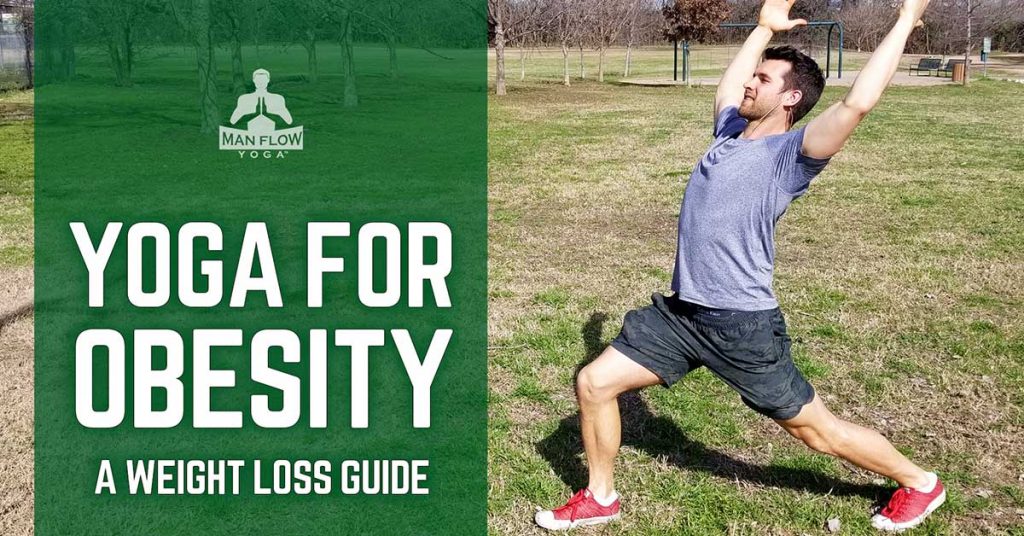
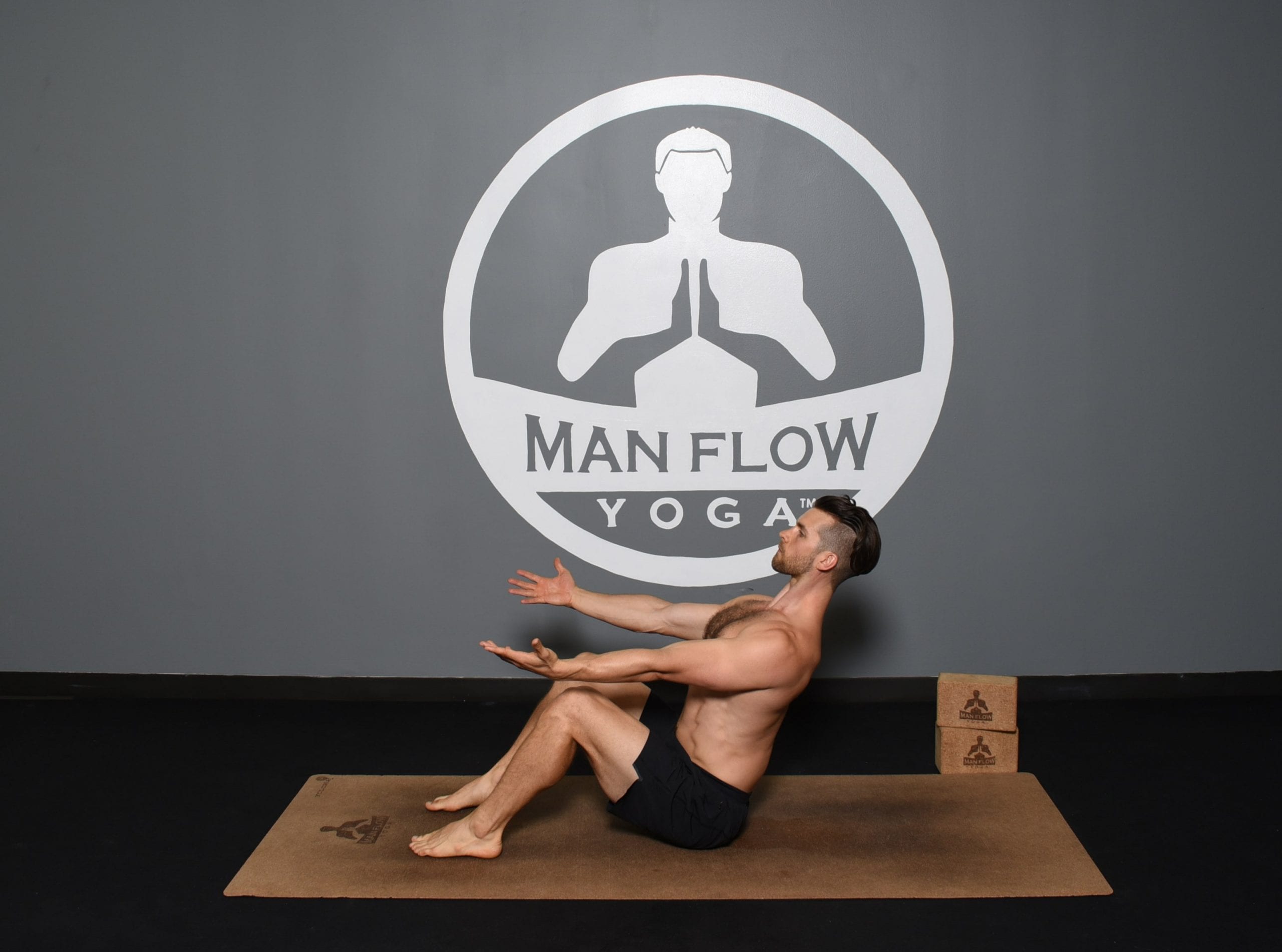
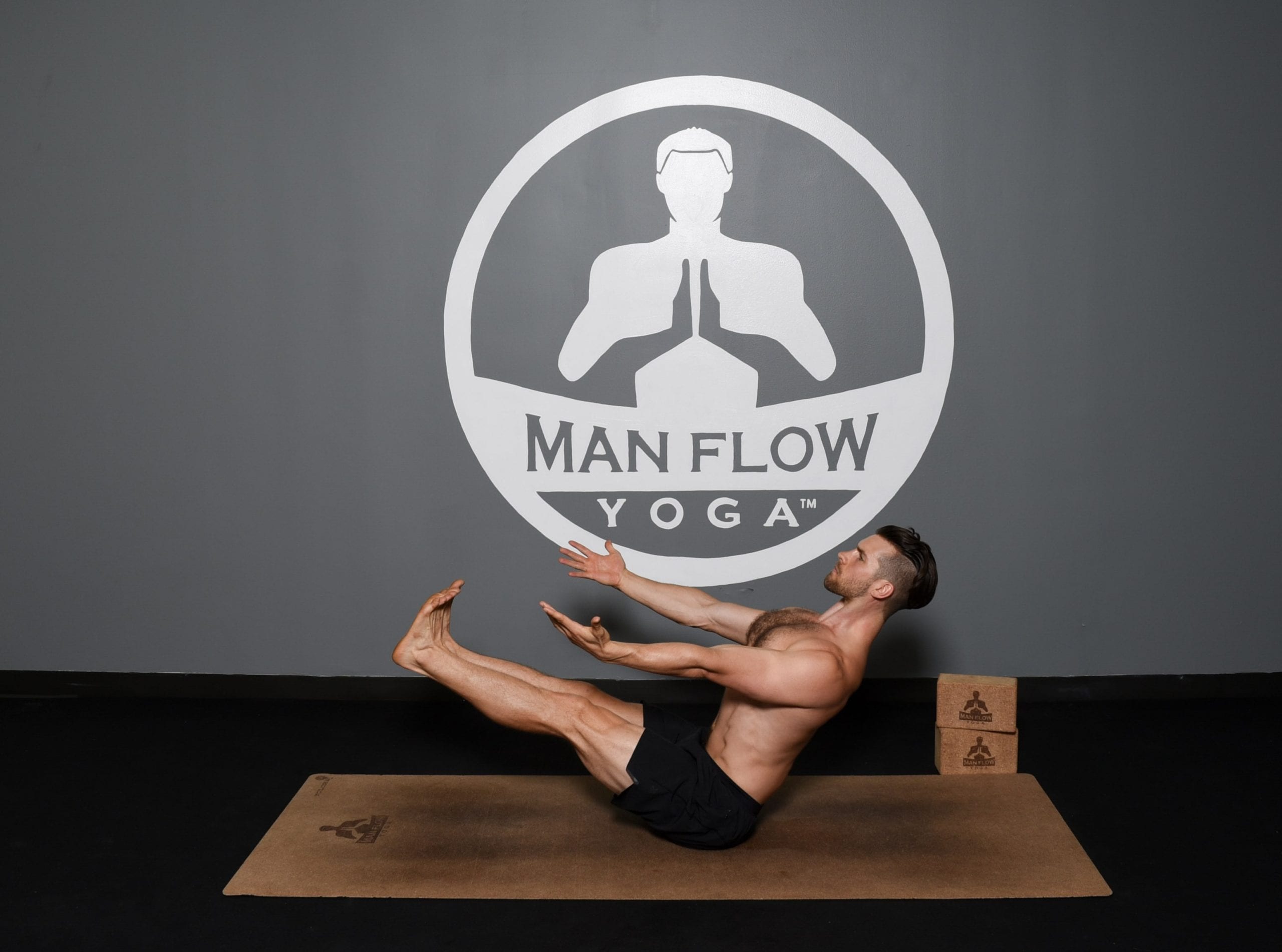
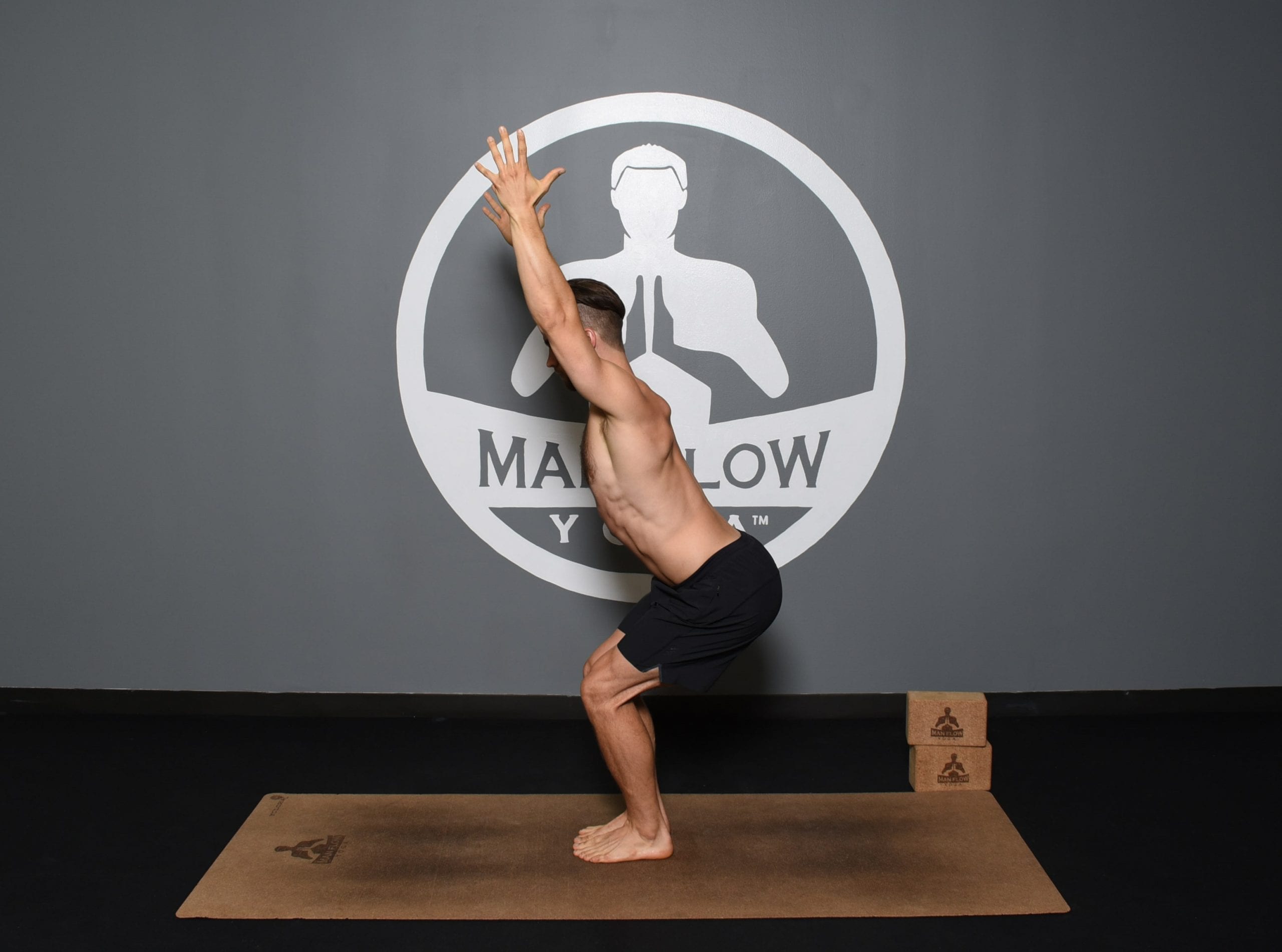


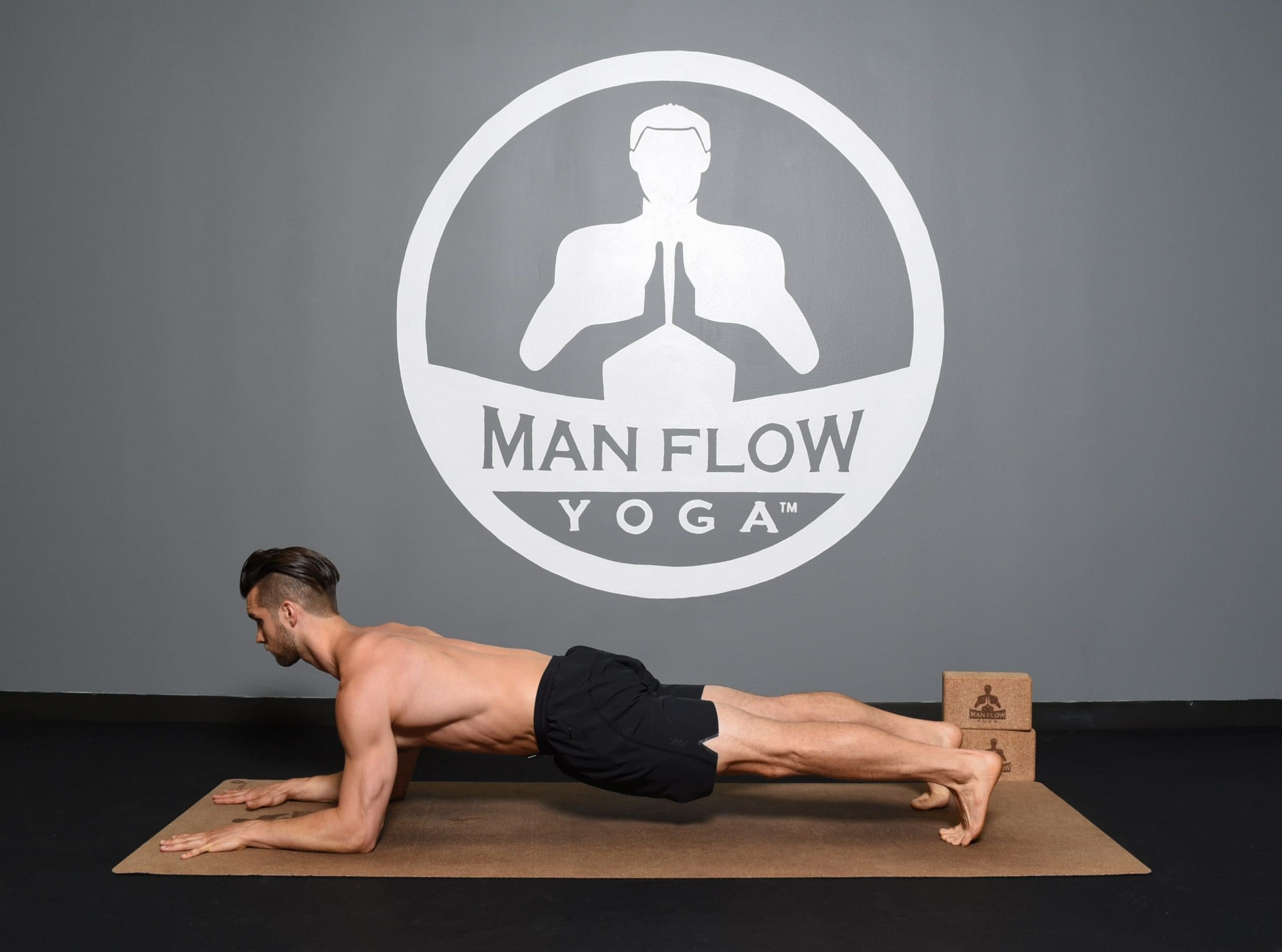
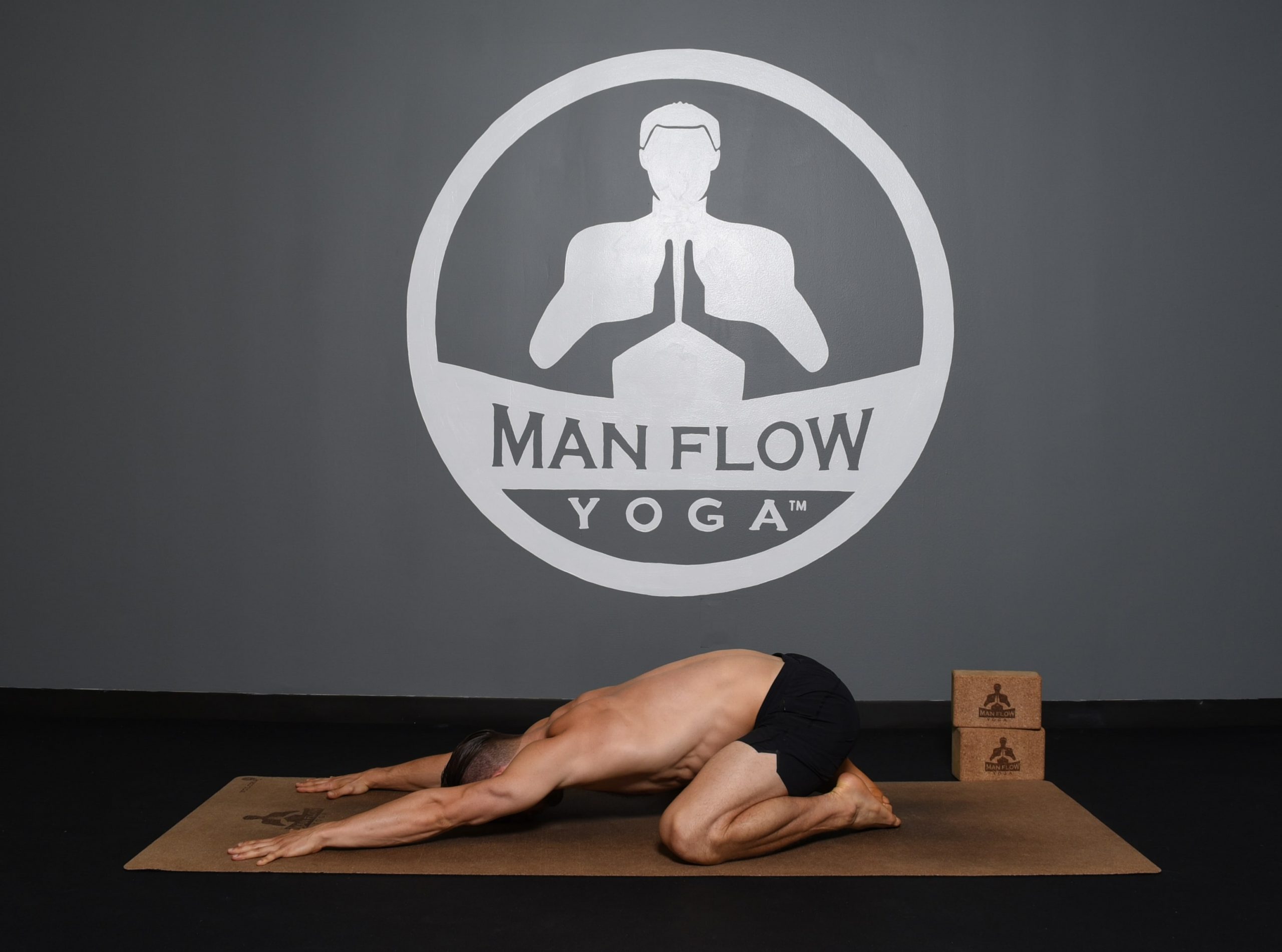
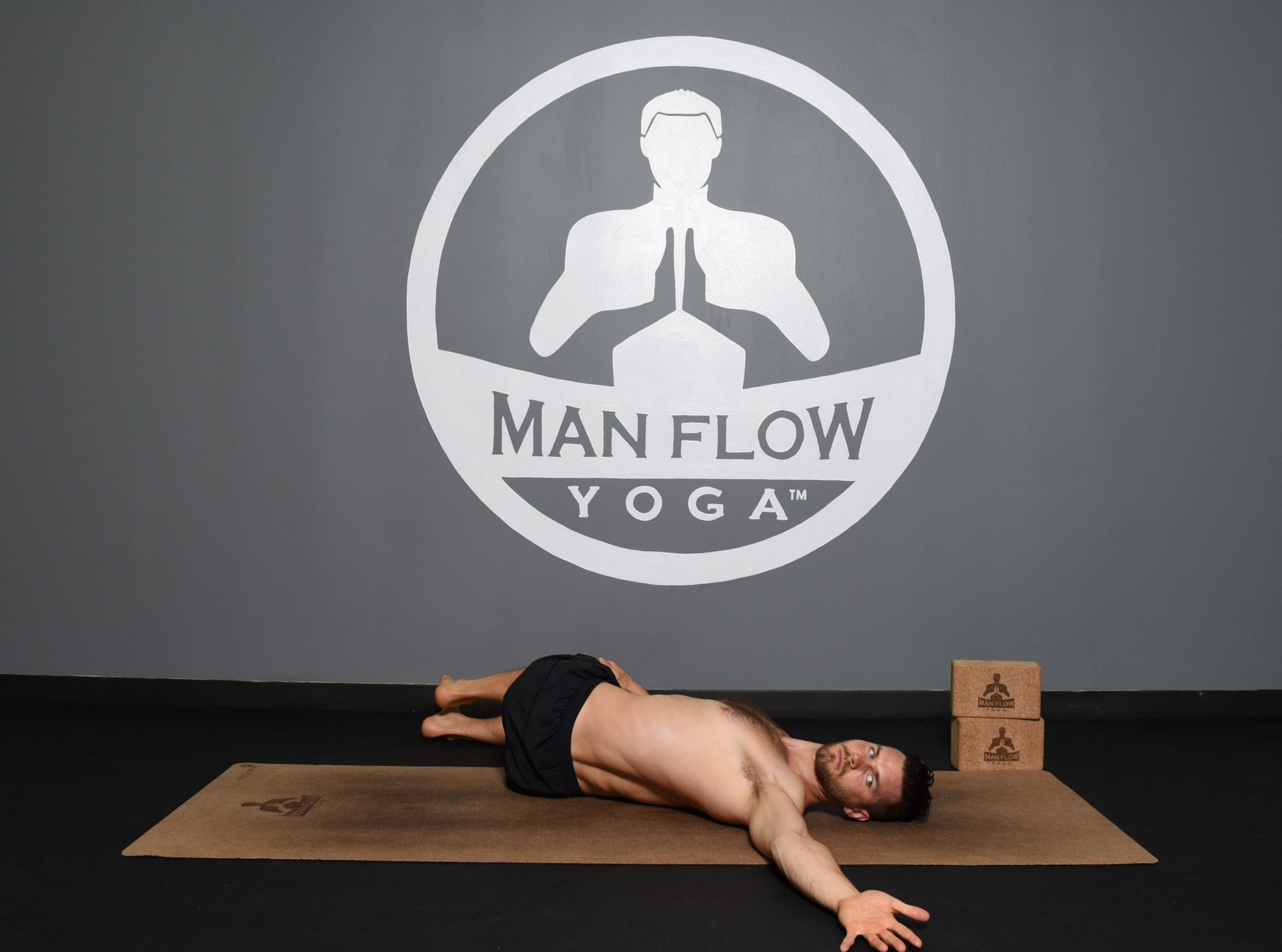
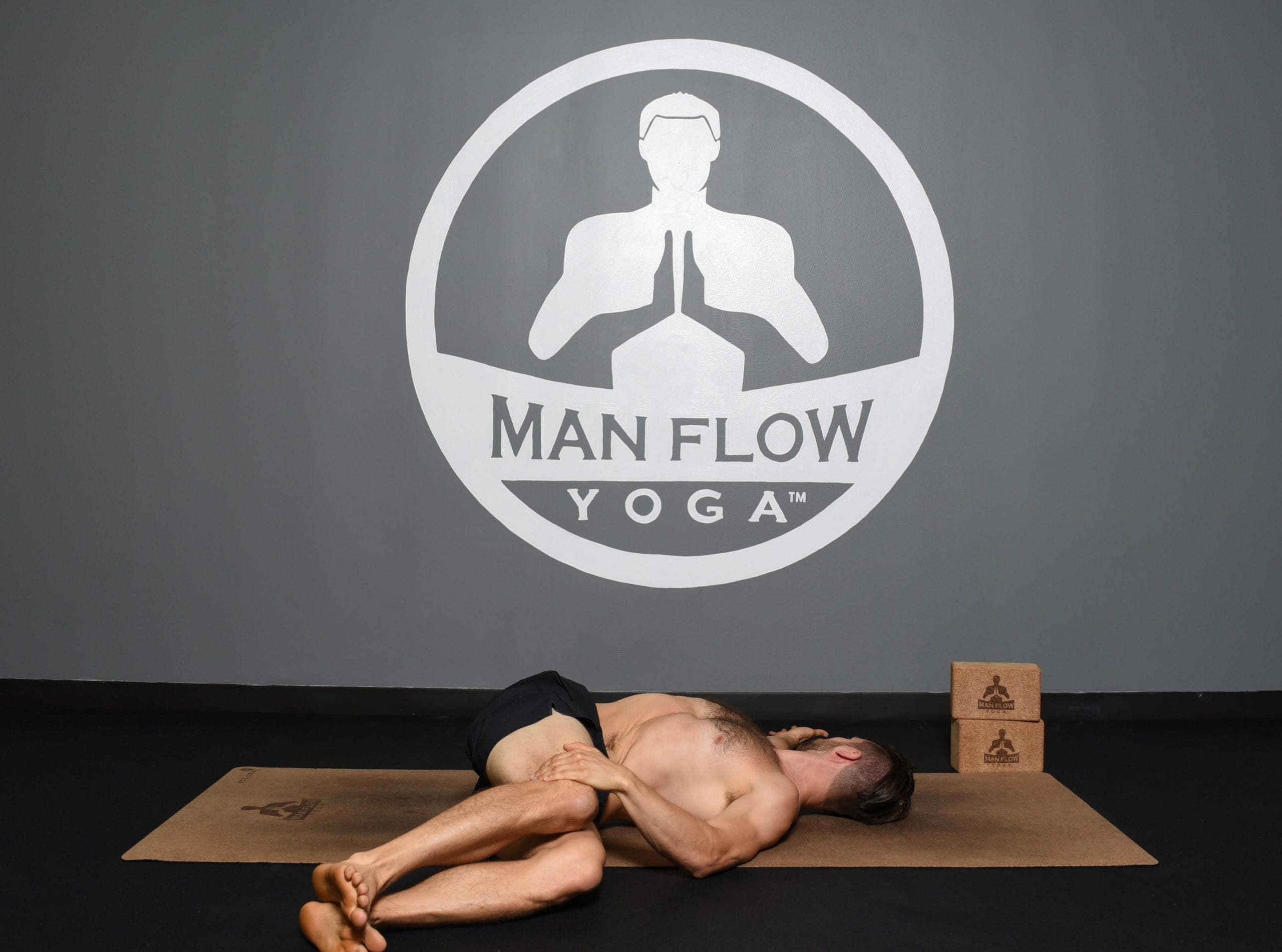
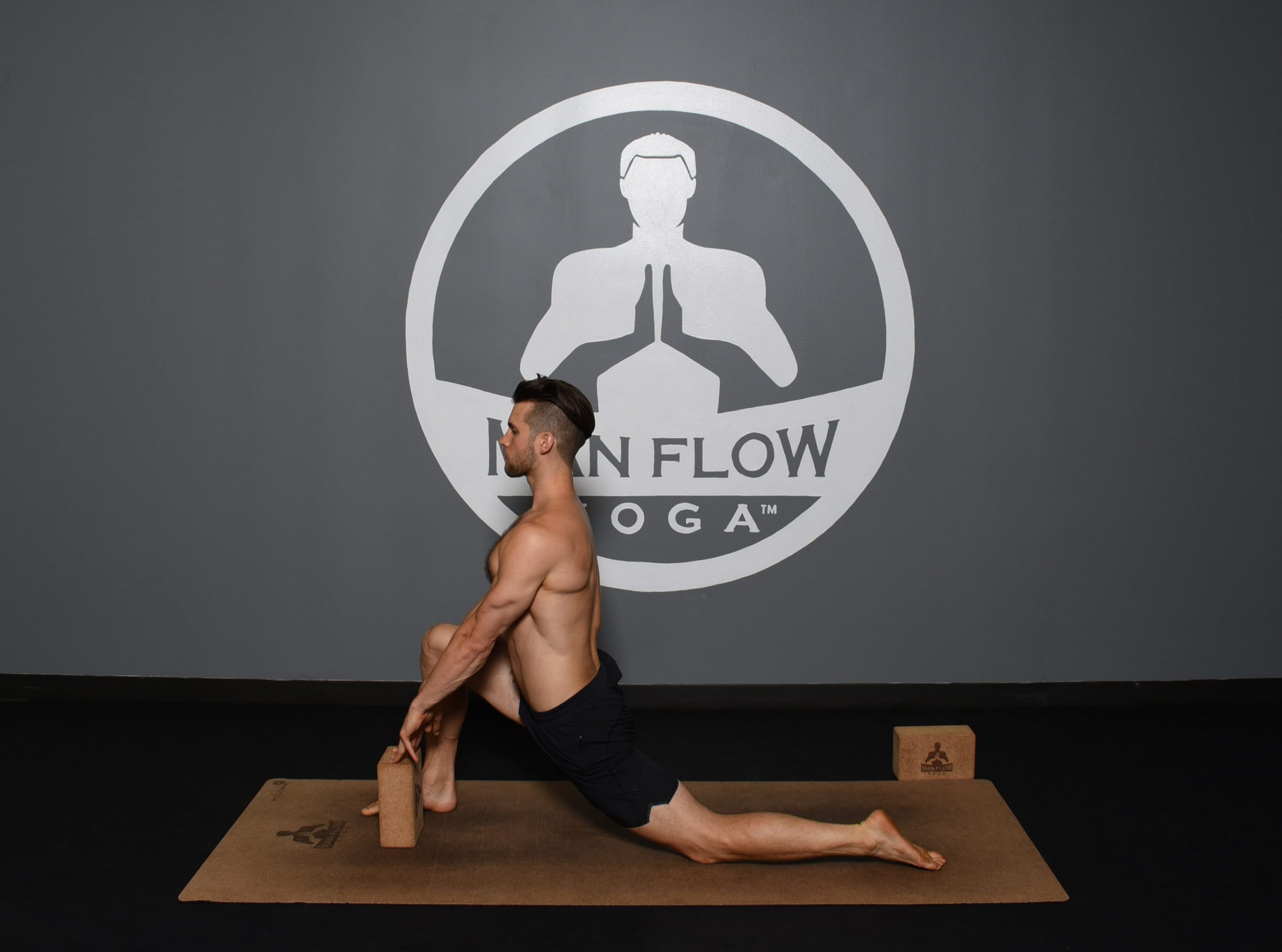
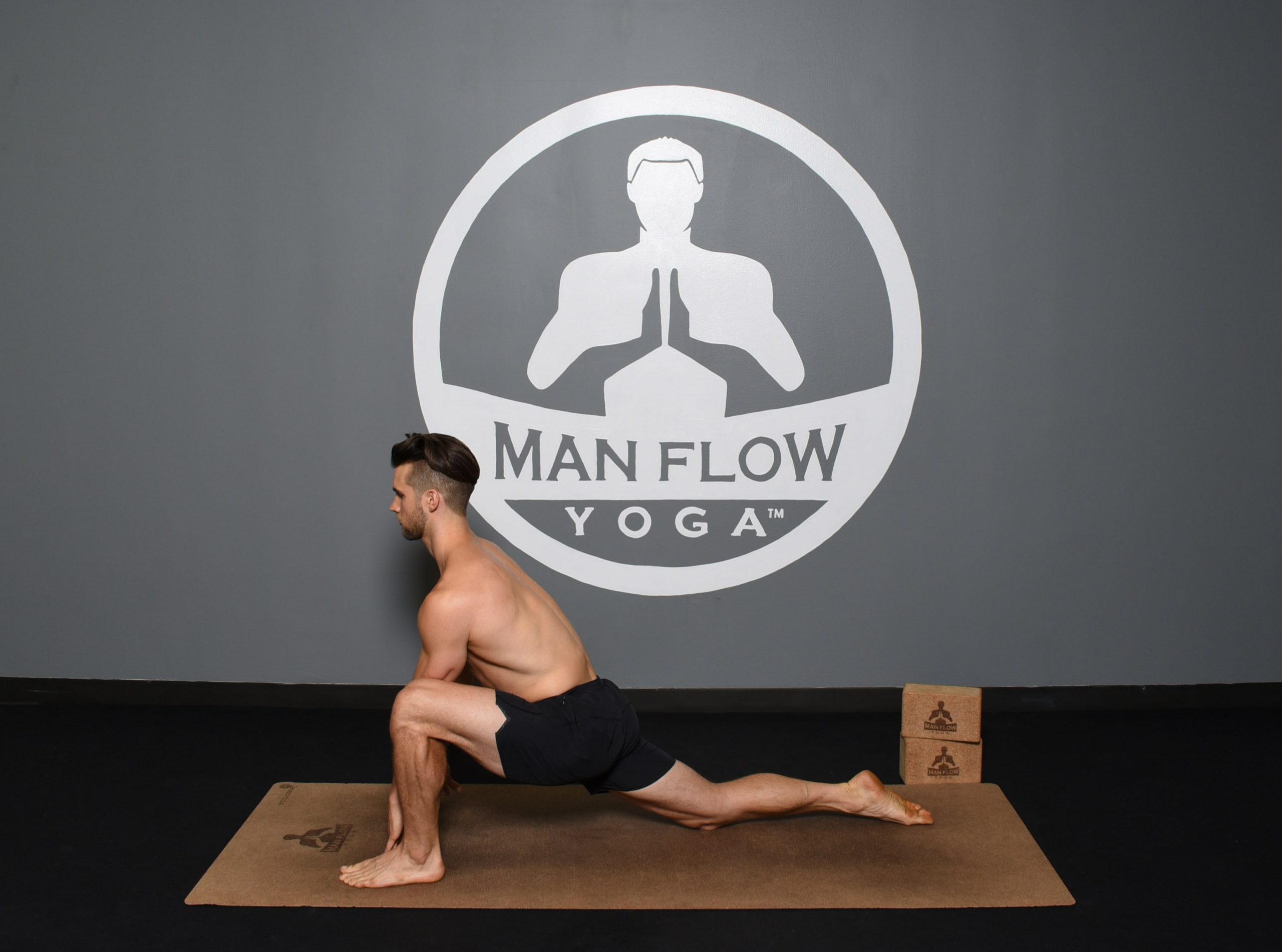
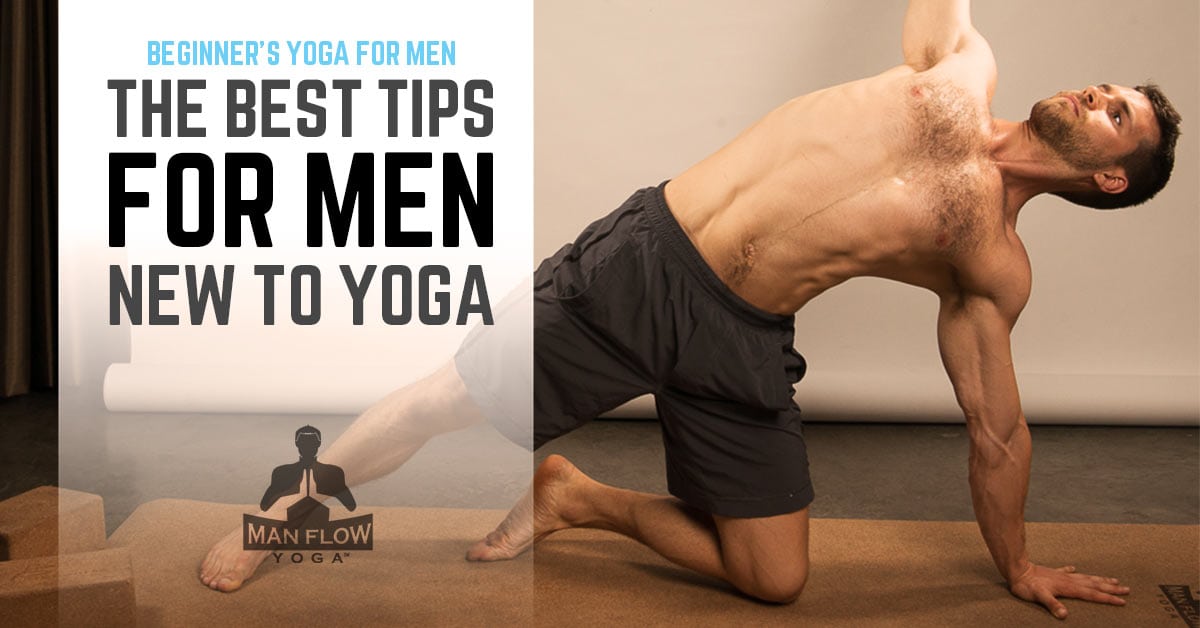
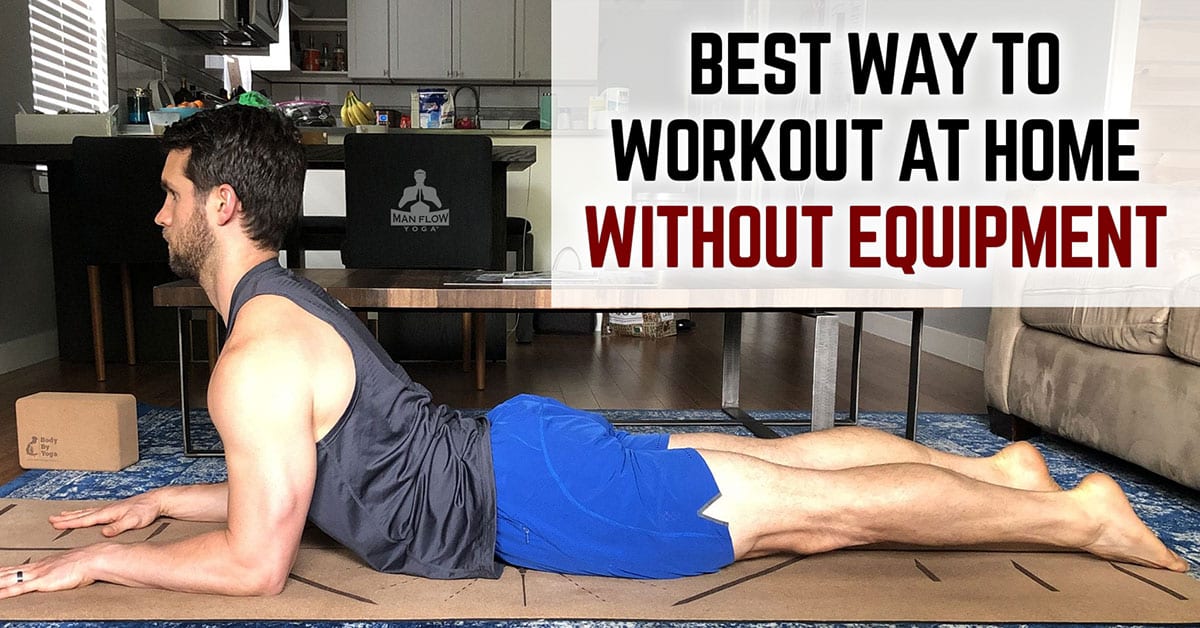
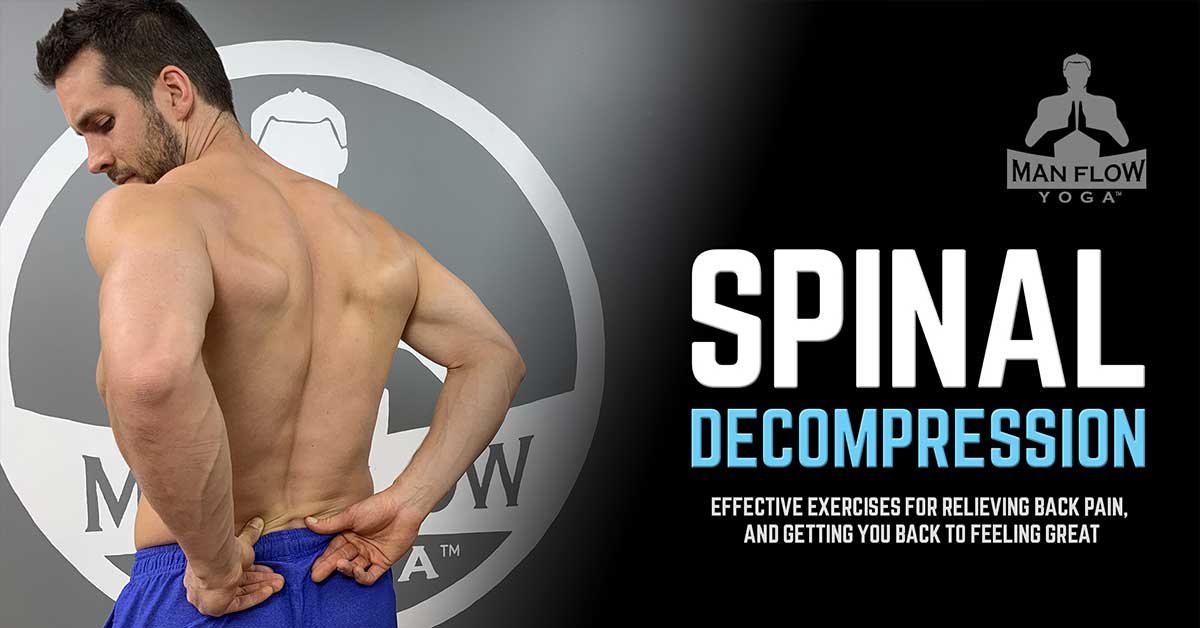
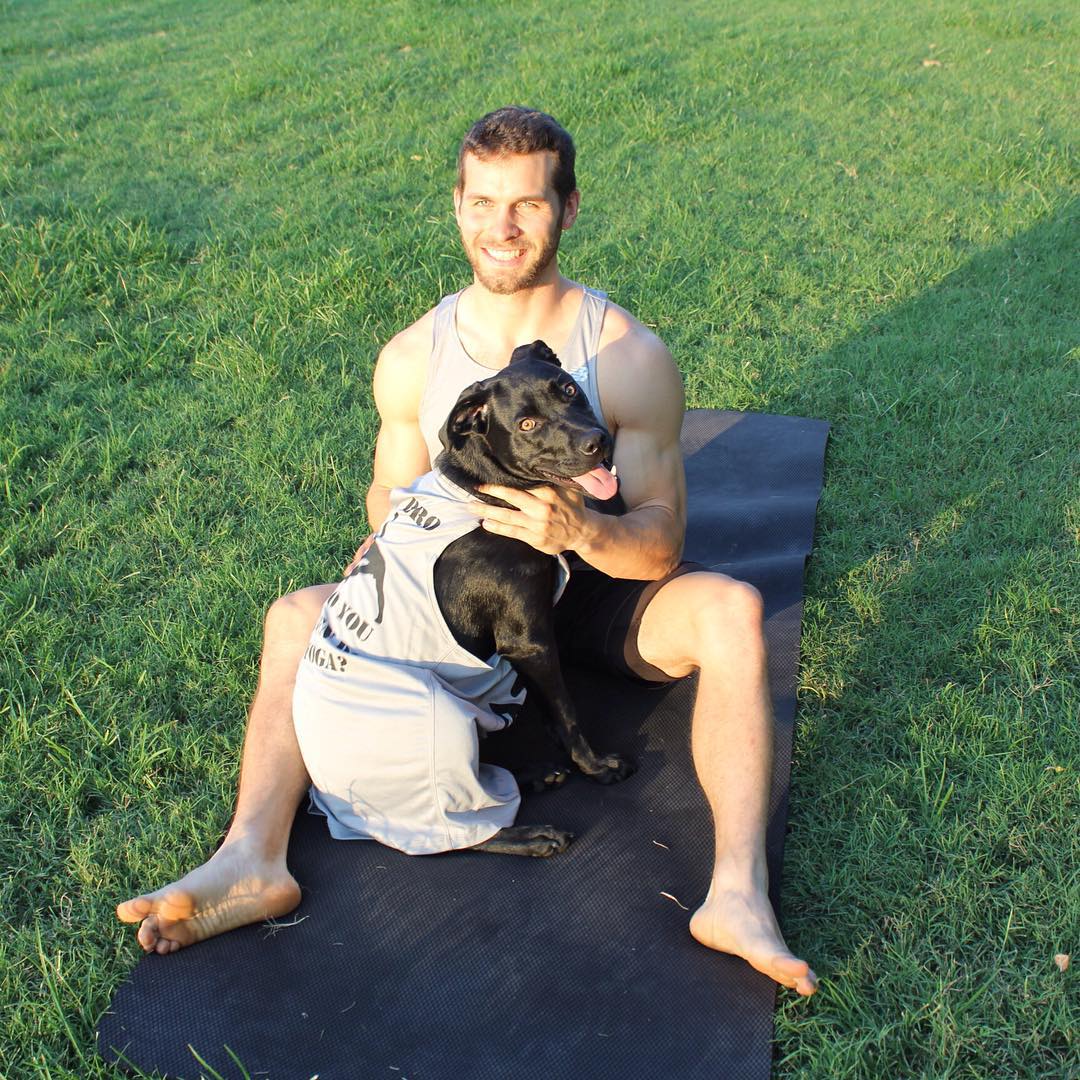
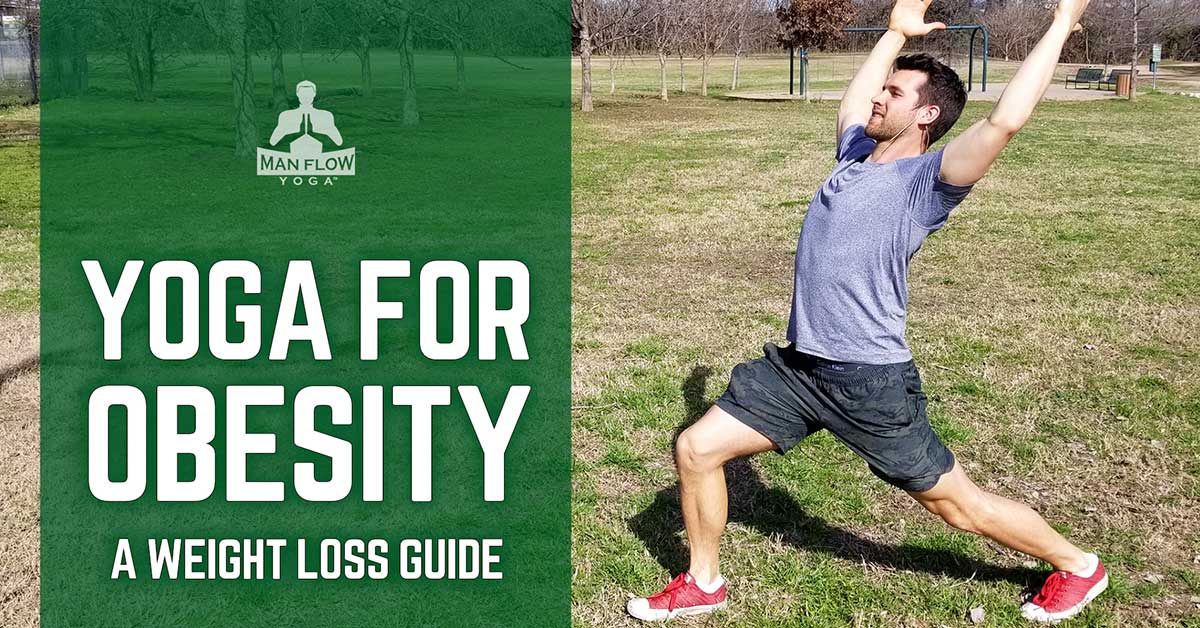
Dean you read my mind. Having been sidelined by fractured ribs, I hadn’t exercised in a while (dr.’s orders). As a result I have gained a significant amount of weight. Being 50+ yrs. old doesn’t help.
So this information is very timely. Question, is there a modification for child’s pose? I have a hard time getting my butt close to my heels due to bad knees. Thanks!
Hey Johnny – thanks! Glad you found this info useful.
Modification for child’s pose, you can do it on your back instead. Hold your knees in toward your sides while keeping your back flat.
Love this! Thank you for sharing such an insightful article!
Glad you enjoyed it Amalie! Definitely the kind of workout a lot of us need these days 🙂